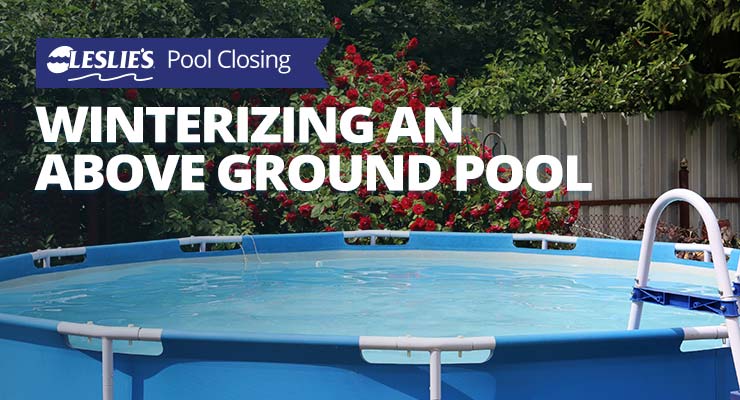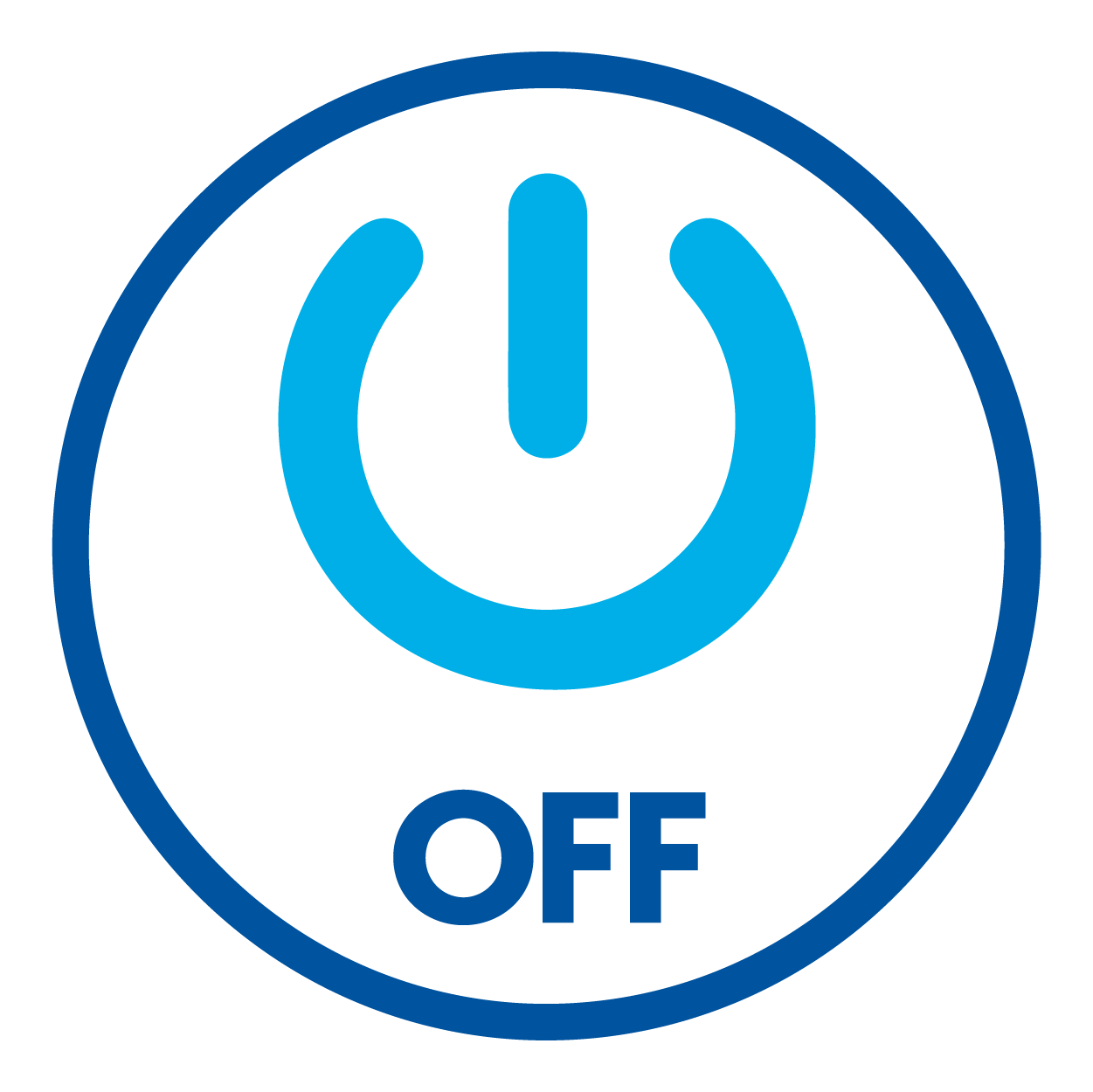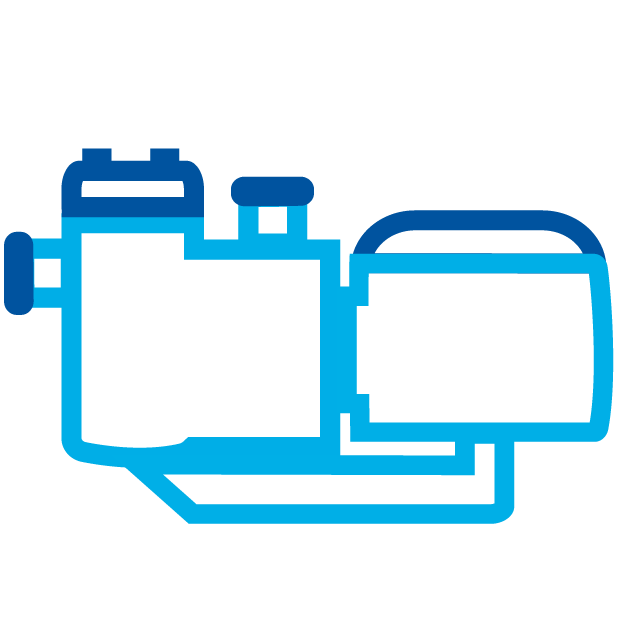
Winterizing an Above Ground Pool
How do you winterize an above ground pool? As the summer winds down, it is time to start getting your pool ready for the cold winter months. Properly winterizing your above ground pool will protect your equipment from ice damage, keep your water clean, and will help save you time and money when opening your pool in the spring.
Winterizing your above ground pool may seem complicated. But with a little preparation, it can actually be a very simple, pain-free process. Leslie's has compiled a set of step-by-step instructions to help you safely and effectively winterize your pool.
DIY TIP: Don't close your pool too early! Winterizing the pool before water temperatures are consistently below 65ºF can set you up for a lengthy, costly pool opening next spring. Warmer water uses up sanitizer more quickly, which increases the risk of algae growth.
Gather Your Supplies
Before getting started, make sure you have all the essential pool closing and winterizing supplies you'll need. It's important to have these items on hand to ensure an efficient pool closing process:

- Water Balancing Chemicals
- Pool Closing Kit or Closing Chemicals
- Skimmer, Brush, and Vacuum Attachments for Telescoping Pool Pole
- Winter Cover
- Cable and Winch Assembly (Usually Included with Winter Cover)
- Leaf Net
- Air Pillow(s)
- Pillow Pal
- Cover Clips, Cover Wrap, or Wall Bags
- Winter Plug
- Skimmer Plug
- Submersible Pump
Winterizing Above Ground Pools for Freezing Conditions
If you live in a climate that will see long periods of freezing temperatures, and you own an above ground pool, these easy-to-follow instructions will help you close your pool at the end of the season. You can also watch this video to walk you through the process:
1. Manage phosphate levels
One week prior to closing your pool, add Pool Magic + PHOSfree directly into the skimmer while the pump is running. Add 14 fluid ounces for every 10,000 gallons of water. As with all pool chemicals, always read and follow product label instructions to ensure proper application.

2. Skim, brush, and vacuum the pool
It's important to make sure your above ground pool is as clean as possible before closing and winterizing it. Start by removing leaves and other large debris with a leaf rake or skimmer net. Next, thoroughly brush all pool surfaces and vacuum any remaining dirt and debris from the pool floor.
3. Prevent stains and scaling
To prevent unsightly stains over the winter months, it's important to add stain and scale prevention products to the water. With the pump running, add the proper doses of MetalFree and/or Leslie's Stain and Scale Remove.
Or, if you purchased a Pool Closing Kit, now is the time to add either the Stain and Scale Pill or MetalFree, depending on which product is included in your kit. Again, always read and follow product label instructions.

4. Test and balance the pool water
Test the water to make sure the Total Alkalinity, pH, and Calcium Hardness levels are within proper ranges, and make adjustments as necessary.
Total Alkalinity should be in the 80–120 ppm range, depending on the type of primary sanitizer used. It should be between 100–120 ppm for dichlor, trichlor, and bromine sanitizers, and between 80–100 ppm for sodium hypochlorite, calcium hypochlorite, or lithium hypochlorite.
Once Total Alkalinity has been addressed, adjust the pH to 7.4–7.6. Finally, make sure the Calcium Hardness is around the ideal of 200–400 ppm.
Need help testing and balancing the water in your above ground pool? Check out our comprehensive guide, How To Balance Pool Water. Just remember, follow all label instructions, and never mix pool chemicals! It's a good idea to wait at least 1–2 hours between chemical applications. If you need to adjust Calcium Hardness levels, do not add a hardness increaser on the same day as sodium carbonate (Soda Ash) or sodium bicarbonate (Alkalinity Up).
BONUS TIP: For the most accurate analysis of pH, Total Alkalinity, Calcium Hardness and other aspects of water chemistry, bring a water sample to your local Leslie's for a free AccuBlue® water test. We'll provide you with a customized water treatment plan that will take all the guesswork out of this step in the pool closing process.
5. Prevent algae growth
Algae can make or break a successful pool opening, so it's important to use the right algae prevention products when winterizing your above ground pool. Add one quart (32 ounces) of Leslie's Algae Control per 25,000 gallons by mixing it with water in a large bucket. Then, with the pump running, pour the mixture around the perimeter of your pool. Wait an hour before continuing to the next step.

6. Add non-chlorine shock
Shock the pool with Leslie's Fresh 'N Clear at the rate of 1–2 pounds per 10,000 gallons by broadcasting the product around the perimeter of your pool. Make sure the pool pump is still running. Wait 30 minutes.
7. Raise chlorine level
Use Leslie's Chlor Brite to bring the chlorine to an appropriate level, between 2.0–4.0 ppm. You can use about 3 oz. of Chlor Brite per 10,000 gallons to increase chlorine levels by 1.0 ppm. Run the pool pump for at least eight hours (or one full turnover) before proceeding to the next step.
8. Clean the pool filter
After the pump has been running for at least eight hours, it's time to clean the filter. Backwash your sand or DE filter, or if you have a cartridge filter, remove the cartridges to manually clean the filter.
9. Add WinterPill
If using a Pool Closing Kit, now's the time to add the WinterPill that's in there. But even if you're not using a kit, a WinterPill helps make for an easier pool opening in the spring. Follow the manufacturer's instructions to puncture the pill and place it in the water.

10. Turn off the power
You're done using the pool equipment for the year. Go ahead and turn off the breaker on the main power source for the pool. Also remove the on and off trippers from the time clock. This will prevent your pump from turning on during the next steps.
11. Remove inlet fitting
Remove the inlet (directional or eyeball) fitting. This is located on the inside pool wall, usually 6" to 12" below the water line. Insert a winterizing plug into the opening.
12. Lower the pool water level
When winterizing your above ground pool, lower the water level around 4" to 6" below the skimmer. You can do this with a submersible pump or by siphoning the water out with a short garden hose. Do not lower the water any more than that, or you'll risk damaging your vinyl liner. When in doubt, always refer to the pool manufacturer's instructions for winterizing procedures.

13. Drain pool equipment and hoses
Remove the drain plugs from the pump strainer basket housing, the pump volute, the filter tank, and the heater. Keep the drain plugs handy — you'll need them in just a minute.
Disconnect the filter hoses from the skimmer fitting and the pool return fitting.
Also drain the automatic chlorine feeder, if you use one.
14. Store pool equipment
Move all the equipment and hoses you removed to a safe, non-freezing location, such as your basement or a heated garage. Store all the drain plugs in your pump strainer basket so they don't get lost. If you'll be leaving your equipment outside for the winter, make sure your equipment is properly winterized. If using a filter with a multiport valve, set the valve to the "Winter" or "Winterize" setting, or between any two settings, to help prevent damage from freeze expansion.
BONUS TIP: If you're unable to move your equipment indoors, it helps to cover it. Use pool equipment covers or a tarp to help protect your stuff from the elements. They make winter covers for patio furniture, as well!
15. Remove and store non-permanent fixtures
Remove all non-permanent articles from the pool. This includes ladders, hoses, over-the-top skimmers, floats, toys, etc. If you have an automatic pool cleaner, remove it and drain it completely. Lay the hoses out straight in a non-freezing location.
16. Inflate air pillow
Inflate and tie air pillows to a stationary object. An average-sized above ground pool, 24' round, typically requires 2 air pillows. Anything smaller than that may only require a single air pillow. If you are using multiple pillows, tie them together using the grommets located on the pillow's corners.

17. Apply winter pool cover
Cover the pool using a winter cover, and secure it with the included cable and winch assembly. If needed, use wall bags, cover clips, or a winter cover wrap to further secure the cover and prevent wind damage.
In areas with a lot of trees, a leaf net can be added over the top of the winter cover to make it easier to remove the leaves.
And that's it! Once the cover's on, you're done winterizing your above ground pool.
Winterizing Above Ground Pools for Non-Freezing Conditions
If you live in an area where temperatures don't often fall below freezing (if at all), you can still follow the above instructions to close your pool. However, there are a few key differences.
Instead of draining the pool, you'll actually want to fill it up completely to the top, almost to the point of overflowing. Skip steps 10 through 14, as they won't be necessary. You'll only need to remove non-permanent fixtures (step 15) if they get in the way of the pool cover, as is often the case with pool ladders.
Throughout the winter, set your pool timer to run the pump about 2–4 hours each day to keep the water circulated. If there's a chance of freezing temperatures in the forecast, run the pump until the risk of freeze damage has passed. A freeze sensor can automate this for you, and further reduce the risk of damage from freezing water expansion.
On the other hand, if you don't want to close the pool at all, that's OK, too! There will be a reduced amount of maintenance needed during the winter months. We go into detail about the different winter options in our blog, Winter Care for Sunbelt Pools.
Looking for a printable checklist? Download our Winter and Off-Season Instructions for Above Ground Pools.
During the cooler off-season months, it's important that you don't forget your basic winter pool maintenance. At least once per month, visually inspect the pool cover for damage, and check the water level to make sure there are no leaks. If the water isn't frozen at the surface, you can also take a water sample to make sure there's still Free Available Chlorine in the pool. NEVER break the ice to collect a water sample — doing so could damage the pool.
If you notice that your pool is starting to change color or surface stains are popping up, bring a water sample to your local Leslie's for a complimentary AccuBlue® water analysis and professional recommendations.